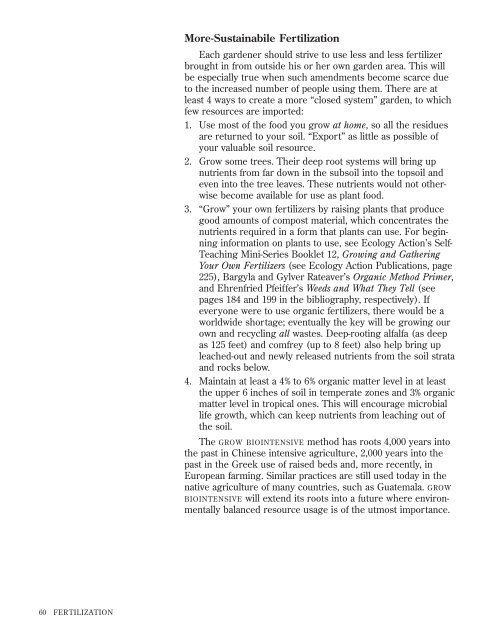How to Grow More Vegetables : And Fruits, Nuts ... - Shroomery
How to Grow More Vegetables : And Fruits, Nuts ... - Shroomery
How to Grow More Vegetables : And Fruits, Nuts ... - Shroomery
You also want an ePaper? Increase the reach of your titles
YUMPU automatically turns print PDFs into web optimized ePapers that Google loves.
60 FERTILIZATION<br />
<strong>More</strong>-Sustainabile Fertilization<br />
Each gardener should strive <strong>to</strong> use less and less fertilizer<br />
brought in from outside his or her own garden area. This will<br />
be especially true when such amendments become scarce due<br />
<strong>to</strong> the increased number of people using them. There are at<br />
least 4 ways <strong>to</strong> create a more “closed system” garden, <strong>to</strong> which<br />
few resources are imported:<br />
1. Use most of the food you grow at home, so all the residues<br />
are returned <strong>to</strong> your soil. “Export” as little as possible of<br />
your valuable soil resource.<br />
2. <strong>Grow</strong> some trees. Their deep root systems will bring up<br />
nutrients from far down in the subsoil in<strong>to</strong> the <strong>to</strong>psoil and<br />
even in<strong>to</strong> the tree leaves. These nutrients would not otherwise<br />
become available for use as plant food.<br />
3. “<strong>Grow</strong>” your own fertilizers by raising plants that produce<br />
good amounts of compost material, which concentrates the<br />
nutrients required in a form that plants can use. For beginning<br />
information on plants <strong>to</strong> use, see Ecology Action’s Self-<br />
Teaching Mini-Series Booklet 12, <strong>Grow</strong>ing and Gathering<br />
Your Own Fertilizers (see Ecology Action Publications, page<br />
225), Bargyla and Gylver Rateaver’s Organic Method Primer,<br />
and Ehrenfried Pfeiffer’s Weeds and What They Tell (see<br />
pages 184 and 199 in the bibliography, respectively). If<br />
everyone were <strong>to</strong> use organic fertilizers, there would be a<br />
worldwide shortage; eventually the key will be growing our<br />
own and recycling all wastes. Deep-rooting alfalfa (as deep<br />
as 125 feet) and comfrey (up <strong>to</strong> 8 feet) also help bring up<br />
leached-out and newly released nutrients from the soil strata<br />
and rocks below.<br />
4. Maintain at least a 4% <strong>to</strong> 6% organic matter level in at least<br />
the upper 6 inches of soil in temperate zones and 3% organic<br />
matter level in tropical ones. This will encourage microbial<br />
life growth, which can keep nutrients from leaching out of<br />
the soil.<br />
The GROW BIOINTENSIVE method has roots 4,000 years in<strong>to</strong><br />
the past in Chinese intensive agriculture, 2,000 years in<strong>to</strong> the<br />
past in the Greek use of raised beds and, more recently, in<br />
European farming. Similar practices are still used <strong>to</strong>day in the<br />
native agriculture of many countries, such as Guatemala. GROW<br />
BIOINTENSIVE will extend its roots in<strong>to</strong> a future where environmentally<br />
balanced resource usage is of the utmost importance.












